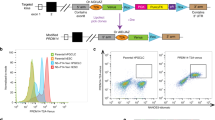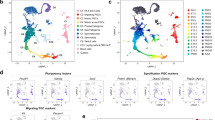Abstract
Specification of germ cell fate is fundamental in development and heredity. Recent evidence indicates that in mice, specification of primordial germ cells (PGCs), the common source of both oocytes and spermatozoa, occurs through the integration of three key events: repression of the somatic program1, reacquisition of potential pluripotency2,3 and ensuing genome-wide epigenetic reprogramming4,5. Here we provide genetic evidence that Prdm14, a PR domain–containing transcriptional regulator with exclusive expression in the germ cell lineage and pluripotent cell lines, is critical in two of these events, the reacquisition of potential pluripotency and successful epigenetic reprogramming. In Prdm14 mutants, the failure of these two events manifests even in the presence of Prdm1 (also known as Blimp1), a key transcriptional regulator for PGC specification6,7. Our combined evidence demonstrates that Prdm14 defines a previously unknown genetic pathway, initiating independently from Prdm1, for ensuring the launching of the mammalian germ cell lineage.
This is a preview of subscription content, access via your institution
Access options
Subscribe to this journal
Receive 12 print issues and online access
$209.00 per year
only $17.42 per issue
Buy this article
- Purchase on Springer Link
- Instant access to full article PDF
Prices may be subject to local taxes which are calculated during checkout






Similar content being viewed by others
References
Saitou, M., Barton, S.C. & Surani, M.A. A molecular programme for the specification of germ cell fate in mice. Nature 418, 293–300 (2002).
Matsui, Y., Zsebo, K. & Hogan, B.L. Derivation of pluripotential embryonic stem cells from murine primordial germ cells in culture. Cell 70, 841–847 (1992).
Yabuta, Y., Kurimoto, K., Ohinata, Y., Seki, Y. & Saitou, M. Gene expression dynamics during germline specification in mice identified by quantitative single-cell gene expression profiling. Biol. Reprod. 75, 705–716 (2006).
Seki, Y. et al. Extensive and orderly reprogramming of genome-wide chromatin modifications associated with specification and early development of germ cells in mice. Dev. Biol. 278, 440–458 (2005).
Seki, Y. et al. Cellular dynamics associated with the genome-wide epigenetic reprogramming in migrating primordial germ cells in mice. Development 134, 2627–2638 (2007).
Ohinata, Y. et al. Blimp1 is a critical determinant of the germ cell lineage in mice. Nature 436, 207–213 (2005).
Vincent, S.D. et al. The zinc finger transcriptional repressor Blimp1/Prdm1 is dispensable for early axis formation but is required for specification of primordial germ cells in the mouse. Development 132, 1315–1325 (2005).
Seydoux, G. & Braun, R.E. Pathway to totipotency: lessons from germ cells. Cell 127, 891–904 (2006).
Ginsburg, M., Snow, M.H. & McLaren, A. Primordial germ cells in the mouse embryo during gastrulation. Development 110, 521–528 (1990).
Sato, M. et al. Identification of PGC7, a new gene expressed specifically in preimplantation embryos and germ cells. Mech. Dev. 113, 91–94 (2002).
Hu, M. et al. Distinct epigenetic changes in the stromal cells of breast cancers. Nat. Genet. 37, 899–905 (2005).
Nishikawa, N. et al. Gene amplification and overexpression of PRDM14 in breast cancers. Cancer Res. 67, 9649–9657 (2007).
Assou, S. et al. A meta-analysis of human embryonic stem cells transcriptome integrated into a web-based expression atlas. Stem Cells 25, 961–973 (2007).
Avilion, A.A. et al. Multipotent cell lineages in early mouse development depend on SOX2 function. Genes Dev. 17, 126–140 (2003).
Takahashi, K. & Yamanaka, S. Induction of pluripotent stem cells from mouse embryonic and adult fibroblast cultures by defined factors. Cell 126, 663–676 (2006).
Youngren, K.K. et al. The Ter mutation in the dead end gene causes germ cell loss and testicular germ cell tumours. Nature 435, 360–364 (2005).
Bernstein, A. et al. The mouse W/c-kit locus. Ciba. Found. Symp. 148, 158–166 (1990) discussion 148, 166–172 (1990).
Tsuda, M. et al. Conserved role of nanos proteins in germ cell development. Science 301, 1239–1241 (2003).
Tachibana, M. et al. Histone methyltransferases G9a and GLP form heteromeric complexes and are both crucial for methylation of euchromatin at H3–K9. Genes Dev. 19, 815–826 (2005).
Saitou, M., Payer, B., O'Carroll, D., Ohinata, Y. & Surani, M.A. Blimp1 and the emergence of the germ line during development in the mouse. Cell Cycle 4, 1736–1740 (2005).
Lawson, K.A. et al. Bmp4 is required for the generation of primordial germ cells in the mouse embryo. Genes Dev. 13, 424–436 (1999).
Downs, K.M. & Davies, T. Staging of gastrulating mouse embryos by morphological landmarks in the dissecting microscope. Development 118, 1255–1266 (1993).
Kurimoto, K. et al. An improved single-cell cDNA amplification method for efficient high-density oligonucleotide microarray analysis. Nucleic Acids Res. 34, e42 (2006).
Kurimoto, K., Yabuta, Y., Ohinata, Y. & Saitou, M. Global single-cell cDNA amplification to provide a template for representative high-density oligonucleotide microarray analysis. Nat. Protoc. 2, 739–752 (2007).
Saitou, M. et al. Mammalian occludin in epithelial cells: its expression and subcellular distribution. Eur. J. Cell Biol. 73, 222–231 (1997).
Nagai, T. et al. A variant of yellow fluorescent protein with fast and efficient maturation for cell-biological applications. Nat. Biotechnol. 20, 87–90 (2002).
Hayashi, K. et al. SMAD1 signaling is critical for initial commitment of germ cell lineage from mouse epiblast. Mech. Dev. 118, 99–109 (2002).
Cox, W.G. & Singer, V.L. A high-resolution, fluorescence-based method for localization of endogenous alkaline phosphatase activity. J. Histochem. Cytochem. 47, 1443–1456 (1999).
Maruyama, M., Ichisaka, T., Nakagawa, M. & Yamanaka, S. Differential roles for Sox15 and Sox2 in transcriptional control in mouse embryonic stem cells. J. Biol. Chem. 280, 24371–24379 (2005).
Kimura, T. et al. Conditional loss of PTEN leads to testicular teratoma and enhances embryonic germ cell production. Development 130, 1691–1700 (2003).
Acknowledgements
We thank A. Miyawaki (RIKEN) for the Venus plasmid, S. Yamanaka (Kyoto University) for the antibody to Sox2, Y. Shinkai and M. Tachibana (Kyoto University) for the antibody to GLP, A. Tarakhovsky (Rockefeller University) and D. O'Carroll (EMBL) for the Prdm1-knockout mice, B. Hogan (Duke University) and K. Lawson (University of Edinburgh) for the Bmp4-knockout mice and K. Hayashi (University of Cambridge) for the Smad1-knockout mice. We thank D. Sipp for his help in manuscript preparation. Y.S., K.K. and Y.O. are fellows in the Special Postdoctoral Researchers Program of RIKEN. This study was supported in part by a Grant-in-Aid from the Ministry of Education, Culture, Sports, Science, and Technology of Japan and by a PRESTO project grant from the Japan Science and Technology Agency.
Author information
Authors and Affiliations
Contributions
M. Yamaji, Y.S. and M. Saitou designed this study. M. Yamaji, Y.S. and K.K. performed phenotype assessment. M. Saitou, Y.Y. and Y.O. helped phenotype assessment. M. Yuasa, M. Shigeta and K.Y. helped generation and propagation of the mouse strains. M. Saitou wrote this paper.
Corresponding author
Supplementary information
Supplementary Text and Figures
Supplementary Table 1, Supplementary Figures 1–7 (PDF 1159 kb)
Rights and permissions
About this article
Cite this article
Yamaji, M., Seki, Y., Kurimoto, K. et al. Critical function of Prdm14 for the establishment of the germ cell lineage in mice. Nat Genet 40, 1016–1022 (2008). https://doi.org/10.1038/ng.186
Received:
Accepted:
Published:
Issue Date:
DOI: https://doi.org/10.1038/ng.186
This article is cited by
-
DNA methylation restricts coordinated germline and neural fates in embryonic stem cell differentiation
Nature Structural & Molecular Biology (2024)
-
Rhox6 regulates the expression of distinct target genes to mediate mouse PGCLC formation and ESC self-renewal
Cell & Bioscience (2023)
-
NvPrdm14d-expressing neural progenitor cells contribute to non-ectodermal neurogenesis in Nematostella vectensis
Nature Communications (2023)
-
Postnatal oogenesis leads to an exceptionally large ovarian reserve in naked mole-rats
Nature Communications (2023)
-
Sertoli cell-only syndrome: advances, challenges, and perspectives in genetics and mechanisms
Cellular and Molecular Life Sciences (2023)



